A Violent Day in the Louisiana Capitol
- Admin
- Feb 15, 2018
- 8 min read
I object to violence because when it appears to do good,
the good is only temporary; the evil it does is permanent.
Mahatma Gandhi
State 28: Louisiana - January 31, 2018
Lori

We woke up at a campsite at the Escapees World Headquarters in Livingston, TX having had a good night sleep. Yesterday, we visited the Houston Food Bank to see how they serve 88 million meals each year, and we can’t wait to see what additional adventures lie ahead. Today, we drive 111 miles East to enter the 28th state on our Cross Country Journey to discover America, and find a new state to call home; Louisiana: A Sportsman's Paradise. I searched long and hard for the top US states for sportsmen, and could not find Louisiana listed on any! It would appear Louisiana is the self-proclaimed “Sportsman's Paradise” However, I did discover Louisiana leads the nation in domestic crawfish production, but I guess hailing Louisiana as a “Crawfish Paradise” doesn’t bring in the tourists. As vegetarians, we do not hunt or fish, and would have a hard time calling a state home who advertises such in their state slogan. Will the Cross Country Couple discover more than just a “sportsman’s paradise” during our week in the state? We can’t wait to begin exploring Louisiana!
The first item on the agenda is a 156 mile drive Northeast to visit the National Park depicted on the reverse of the Louisiana Quarter; Kisatchie National Forest. Designated on June 10, 1930 by President Herbert Hoover, Kisatchie National Forest is Louisiana’s only national forest consisting of several large areas due to fragmentation by private land ownership. With 604,000 acres, more than half consists of protected long leaf pine tree forest, which have significantly decreased over the past century. In addition to the long leaf pine tree, Kisatchie National Forest plays an important role protecting rare plant and animal species which include: the pale pincher carnivorous plant, the Louisiana pine snake and the Louisiana black bear. (I really hope I do not run across any bears, snakes or carnivorous plants EEEEK!) Natural prairies have been almost been entirely destroyed in Louisiana due to clearing for agriculture. In addition to forest and wildlife, Kisatchie protects the 769 acre Kiefffer Prairie, which is the largest in the state!
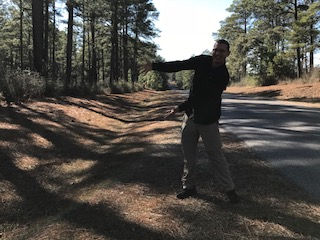
It has become a tradition for us to take a picture next to the sign at the entrance of each national park, but for the life of us we could not find the sign for Kisatchie National Forest. To complicate matters further, the forest did not have a visitor center, and we could not find anywhere to get our national park passport stamped! By chance, we happened across a maintenance building, and went in to speak with one of the workers. He stated that someone stole the sign to the entrance to the forest a while back, provided us with a map, and made an X on it to signify where the sign once stood. Perhaps they should have the sign made out of stone or metal, which is more resistant to theft! What I found most disturbing was the maintenance man knew the exact location of the missing sign, but no one bothered to have the sign replaced. Kisatchie is the national forest depicted on the Louisiana State Quarter, and should be the best representation of the state’s parks! No one seemed to even care the sign was missing, and visitors could not find the entrance! I hope this is not a “sign” of what is to come during our week in Louisiana! Nevertheless, we followed the maintenance man’s map to the approximate location to where the Kisatchie National Forest's sign once stood. Despite no sign being present, we took our ceremonial picture to signify our arrival.
Kisatchie Forest offers a variety of recreational activities including: bird watching, photography, backpacking, canoeing, all-terrain vehicle trails, boating, camping, cycling, fishing, hiking, horseback riding, hunting, mountain biking, picnicking, swimming, 40 developed recreation sites and over 100 miles of trails. However, once I learned there were bears, snakes and carnivorous plants in Kisatchie, there was absolutely no way I was going to any of the aforementioned. In a compromise, Nate and I agreed to explore the forest via the 17-mile Longleaf Trail Scenic Byway. Although the Long Leaf Pines were interesting, overall I found the byway to be boring, and not that scenic. There were very few pull offs, and not that much beauty to see. Perhaps this forest is beautiful by Louisiana's standards, but despite my best efforts, I just wasn’t seeing it. Apparently others didn’t see the beauty either, because we didn’t encounter a single soul during our entire drive on the 17-mile road. However, it is quite possible the reason we were all alone on the scenic byway was due to the sign being missing, and no one could find the entrance to the forest. Please see the pictures below.
Nate
After departing Kisatchie (God bless you LOL), we drove 123 miles Southeast to Baton Rouge, to visit the Louisiana Capitol Building. Home to 227,715 residents, Baton Rouge is the second largest city in Louisiana, and is located on the Eastern bank of the Mississippi River. The Port of Baton Rouge is the furthest inland port on the Mississippi River that can accommodate large ocean tankers and cargo carriers due to its deep water access, and the ships transfer their cargo at Baton Rouge onto rails, pipelines, trucks or barges. The city has a subtropical climate with mild winters, hot and humid summers, heavy rainfall, and the possibility of tornadoes throughout the year. The largest employers in Baton Rouge are: The State of Louisiana, Baton Rouge Public Schools, Louisiana State University, City of Baton Rouge, and an Exxon Mobil Refinery. Government jobs and a refinery do not constitute a well-diversified economy. In addition, the pollution from the port and the refinery had clearly taken its toll on Baton Rouge. Poverty was rampid, buildings were long since abandoned and collapsing, the streets were filled with litter, and graffiti was everywhere. Having already explored 28 states, Baton Rouge was the dirtiest and dilapidated capitol city we had encountered, and I hope the capitol building was in better shape than Baton Rouge.
It is impossible to discuss the Louisiana State Capitol building without talking about a man named Huey Long. On May 21, 1928, Huey Long was elected Governor of Louisiana, and made it his personal mission to construct a new capitol building unlike any other. Governor Long entrusted the capitols design to Louisiana Architect; Leon Weiss. Instead of the traditional rotunda and wing design capitol, Weiss designed a modern skyscraper 450 feet tall consisting of 34 stories, making it the tallest state capitol in the United States! Governor Long secured one million dollars in funds from the Board of Liquidation, and another four million from issuing bonds for a final construction cost of five million dollars! In November 1930, construction of the Louisiana Capitol began. Long insisted the new capitol be finished before the end of his term as Governor, and the building was completed in only 13 months!
After parking Rosie, we waked across the capitol grounds, and made our way to the main entrance. However, the building was surrounded by scaffolding, and undergoing a restoration making the main entrance very difficult to find. We walked into the first entrance we saw beneath a staircase, and were met by two men dressed in suits, whose hands went right on their guns upon our approach. “CAN I HELP YOU?” they stated in a very authoritative manner! Unknowingly, I had found myself somewhere I did not have the authority to be! Attempting to diffuse the situation, I replied, “Good afternoon, can either of you please direct me to the tour desk for the capitol?” One of the men appeared to relax and directed me to the correct entrance. However, the other man’s hand remained hidden beneath his jacket, while he intently stared at my hands! Immediately we departed for the correct entrance to the capitol as we clearly had overstayed our welcome. The visitor's entrance was on the opposite side of the building requiring us to walk around and through an active construction site restoring the outside of the 34 story building! The external façade of the capitol consists of Alabama limestone, which is very porous requiring periodical cleaning. Please see the pictures below of the tallest capitol building in America!
After safely making it to the front of the building, we were searched by security, and made our way to the tour guide's desk in the building's central room. This room was absolutely breathtaking! There were 21 different types of marble from all over the world, 4 full size statues depicting prominent Louisianans, and a large bronze depiction of the state seal on the floor in the center of the room. In the far left corner was scaffolding erected 4 stories high, and an artist was performing restoration work on the ceilings! Please see the pictures below.
After providing a tour of the central room, our guide led us to the Louisiana House and Senate, and outside of each chamber were a different and disturbing versions of the Louisiana State flag depicting a “pelican in her piety”. The mother pelican sits in a nest with her wings out stretched with her three young beneath. The mother pelican deliberately wounds her breast with her beak producing 3 drops of blood to feed each of her young. Beneath the pelican's nest is the words Union, Justice and Confidence. However, from 1912 when the flag was adopted until 2006, the three drops of blood were omitted from the flag. In 2006 the state flag was redesigned to include the 3 drops of blood from the sacrificial pelican. The image of the “pelican in her piety” originated in the Middles Ages, and symbolizes the sacrifices of Christ’s crucifixion. However, despite a pelican’s nurturing nature, there has never been a known instance of pelicans tearing their own flesh to feed their young. I found both flags to be violent and factually false! The 1912 version of the flag without the blood resides outside of the Senate, and the 2006 with the blood resided outside of the House. Please see the pictures below.
We were then led into the House and Senate Chambers which were beautiful, but largely unremarkable with one exception. On Sunday, April 26, 1970, 10 sticks of dynamite were detonated in the Senate Chamber causing over $50,000 in damage. The bombing was reportedly in retaliation for the police murdering 3 African Americans. Fortunately, no one was injured, since the bombing occurred on a Sunday. To this very day, a shard of wood remains embedded in the ceiling of the Senate resulting from the blast. Please see the pictures below.
After exiting the House and Senate Chambers, we were lead down a long hall, which was the sight of the assassination of Louisiana Senator, and Former Governor; Huey Long. On September 8, 1935, Huey Long was at the State Capitol attempting to pass a legislative bill to remove Judge Benjamin Henry Pavy. After the bill passed, Judge Pavy’s son-in-law Carl Weiss approached Long outside of the Legislative Chamber, and shot him once in the torso. Long's bodyguards returned fire shooting Weiss over 40 times and killing him instantly! Huey Long died 2 days later on September 10 at 4:10 a.m. Long's body lay in wake in the state capitol rotunda, and over 200,000 people descended upon Baton Rouge to pay their final respects. Long was buried on the grounds of the new state capitol beneath a statue erected in his likeness. A plaque in the hall signifies the location of the assassination, and the marble walls of the hall are riddled with bullet holes even to this very day. Interestingly, the cause of death on Long’s life insurance claim filed by his family is listed as accidental, and it has been suspected Huey Long may have been accidentally killed by one of the 40 ricocheting bullets fired by his bodyguards. The Louisiana State Capitol is referred to as Huey Long’s Monument due to his efforts in the capitol's construction, his service to the state, and it being his final resting place. Please see the pictures below.
Upon the conclusion of the tour, we took an elevator to the 24th floor, and then a smaller elevator to the 27th floor to the observation deck offering views of Baton Rouge, the Mississippi River, the refinery polluting the atmosphere, and we could even see Rosie! Please see the pictures below.
Typically, I criticize capitols for indiscriminately searching visitors at the door. Considering their state flag features drops of blood, the building was once bombed, and it was the site of their former Governor’s assassination, I can understand why additional security is warranted. Visiting the Louisiana Capitol building was a very negative and disturbing experience! After departing the Louisiana Capitol we drove to a Walmart 60 miles Southwest to Lafayette where we spent the night.














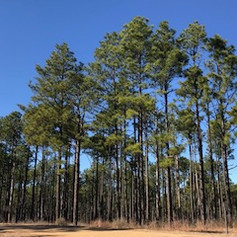
















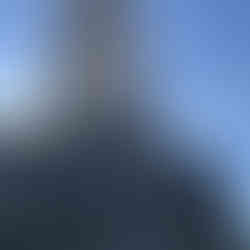




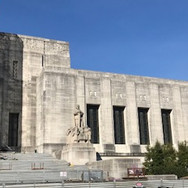









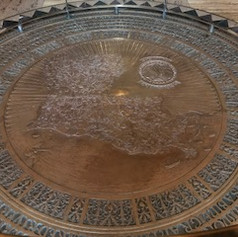














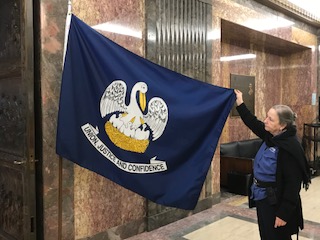
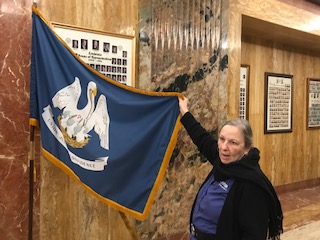




















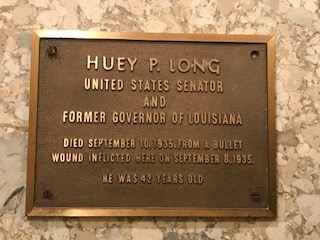



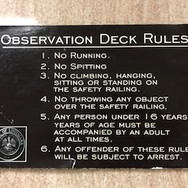


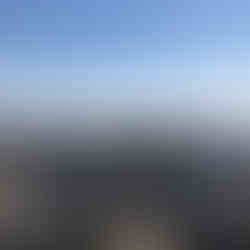























Comments